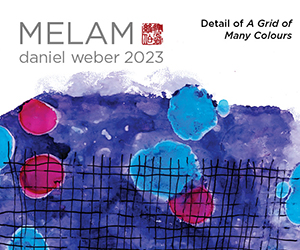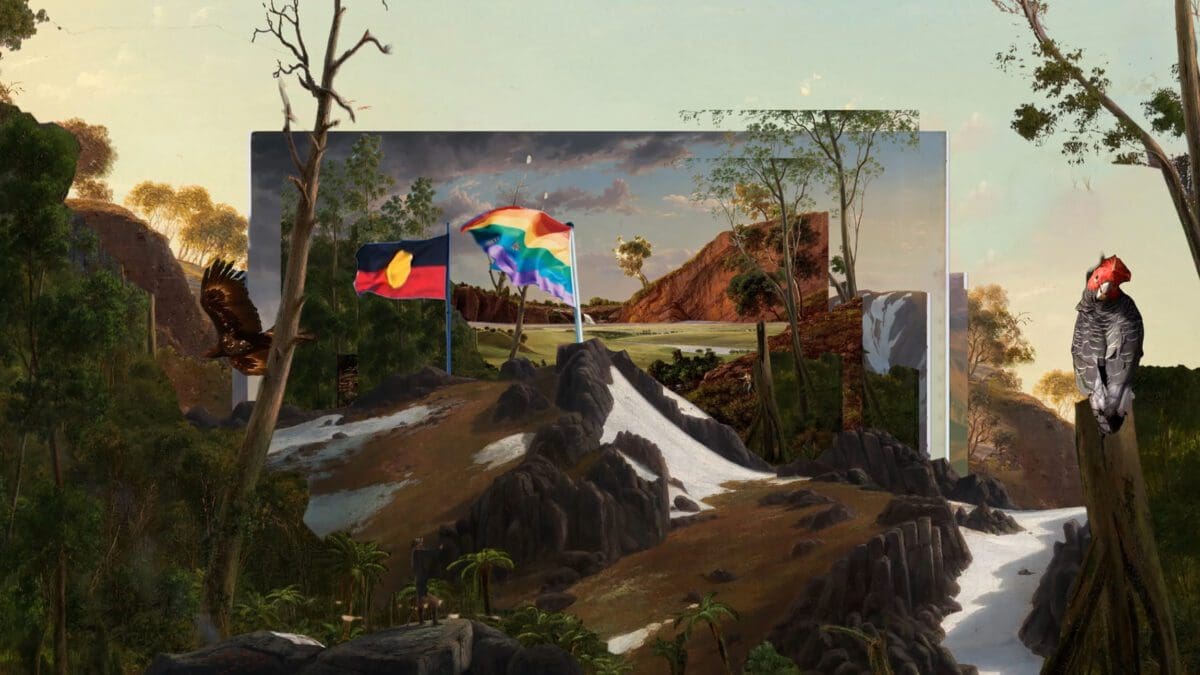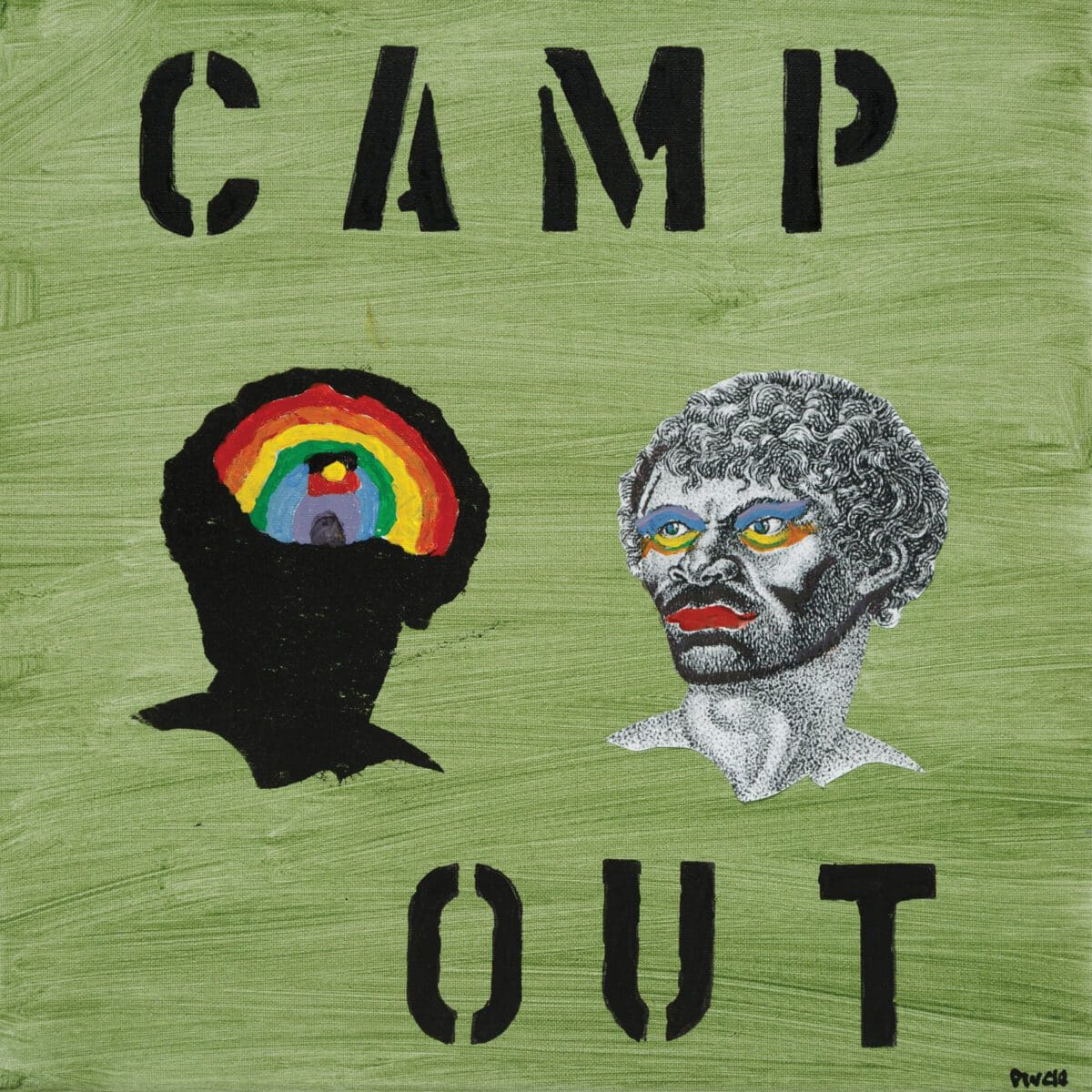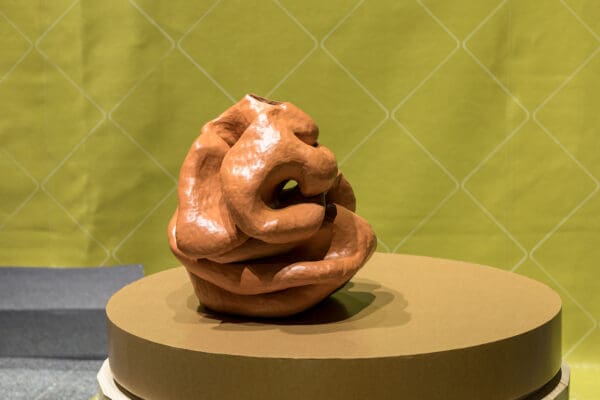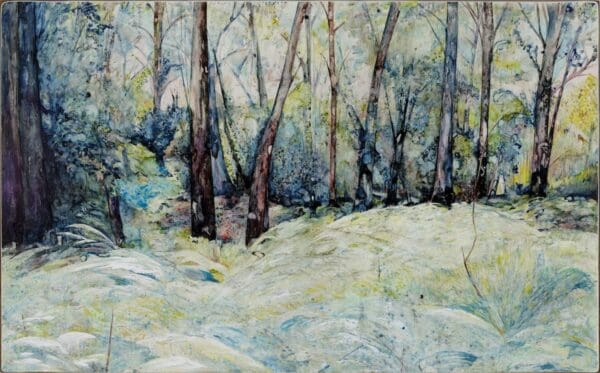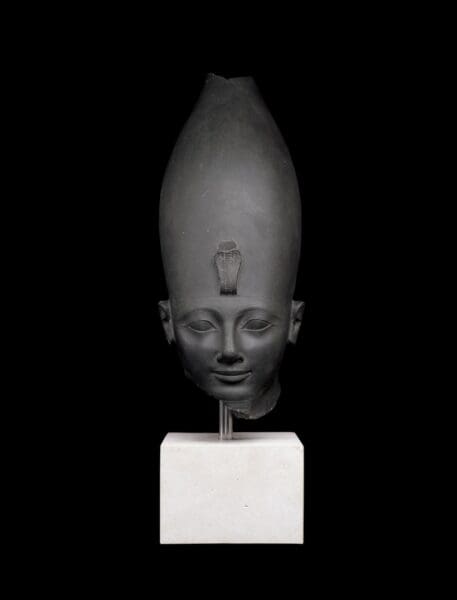As an artist who explores the intersections of his Indigenous queer identity, Peter Waples-Crowe pushes expectations. Moving between various mediums and contexts, he’s known for his collage, painting, mixed-media, fashion and ceramics— and has recently expanded into theatre design and moving image. He co-designed the set for Griffin Theatre Company’s Dogged in 2021 and created the 2022 video Ngaya (I Am) for ACMI. The latter is an eclectic fusion of memoir and found image that speaks to both the power and erasure of Country through subverting colonial iconography.
“I’m really excited about having a show on Kaurna Country. But I also panicked a bit. I thought, “Can I do this, and do I have enough work?” But I do have enough work and I am doing it.”
This work will also be showing in Pride at Adelaide Contemporary Experimental, the artist’s first major exhibition outside of Naarm/Melbourne, offering space and time for Waples-Crowe to reflect on and display critical pieces from the last five years. Timmah Ball talks with Waples-Crowe about how his art intersects with his health and social justice work, and how Pride signals a sense of closure alongside new directions.
Timmah Ball: This is your first major exhibition outside of Naarm. What has it been like preparing to have your work exhibited in another city on Kaurna Yarta Country?
Peter Waples-Crowe: I’m really excited about having a show on Kaurna Country. But I also panicked a bit. I thought, “Can I do this, and do I have enough work?” But I do have enough work and I am doing it. I haven’t had lots of big solo shows before, so it’s exciting. As it gets closer, I get happier about being able to show my work in a different space and place. Particularly because I’m place based, and my work is really connected to me living in Naarm.
I also think that when you’re an independent artist, which is a good thing to be, you can choose whatever you want to do, and you’re not super tied down to anything. I’ve been able to shift and change my practice. And even though there are common themes running through it, overall I think it just gives Adelaide a chance to see what I do and the trajectory I’m on. There’s a lot of pivotal work in the show like my Ngarigo Queen – Cloak of Queer Visibility, which is being loaned from the Victorian Pride Centre. And Pride is also a part of Tarnanthi Festival which I’ve never been part of before.

TB: I’ve always loved your collage works and the intimacy these hold, but I was excited and curious to see you move into film. In some ways it feels like a distinct shift, but I recently read an interview where the artist and poet Jazz Money beautifully describes the connection between working across film and poetry, explaining how “both take a pre-existing language or set of images and arrange them in complimentary, contrasting, or contradictory ways to communicate something to an audience. And in that pairing, you create a third space where new knowledges are revealed.” Can you describe how the medium of film coalesced with your existing practice and the process of making the video work, Ngaya (I Am)?
PWC: Ngaya (I Am) is my practice, but it’s just extended into something different. I’ve always loved working collaboratively and I worked with [cinematographer] Rhian Hinkley on this film. He was like the technical wizard, but I was directing and pulling the essence of my practice into it. I’m known for collaborating with other artists in the past, and I think that working with Rhian has taken my practice in new directions.
It often feels like there’s this purity or an idea of what an artist should do, an expectation that she should do all the film work and have been across all the technologies. But it worked so well collaborating with Rhian. I could ask, “Can you do this?” and he could make it all happen and this made the process really fun. We would salvage YouTube clips which was enjoyable, humorous, and a way to subvert colonial images. But in doing so I’m also commenting on Ngarigo Country.
“I think that’s also why I like collaborations; they allow you to push your practice past the skills you have by working with someone else. I’ve always enjoyed this process, and I’ve probably gotten better at it.”
After working with Rhian, we’re going to go on further. We enjoyed it so much that we’ll probably do something else together in a more collaborative way. I would like to keep extending things further. I think that’s also why I like collaborations; they allow you to push your practice past the skills you have by working with someone else. I’ve always enjoyed this process, and I’ve probably gotten better at it.
TB: As someone who works across health and social justice spaces, as well as being a practising artist, can you talk about how these feed into your work holistically? To me personally it really seems to intersect with your strong desire to collaborate and work with young mob too.
PWC: I think it’s just what I’ve always done, and I really like the balance. I like the challenge of health promotion, education, and stuff like that as well. And I think it’s quite creative, too, because you are creating resources for the community. And now I’m mainly focusing on [working with] Rainbow Mob, LGBTIQ+, and brotherboys and sistergirls.
The way I’m feeling about it is that it is part of my own personal journey. I’ve been trying to do a lot of healing and looking after myself.
“In the exhibition I got to include work by local young mob like Jayda Wilson and I really like the idea of mentoring and having intergenerational conversations.”
And because I worked in the space of keeping people safe from blood-borne viruses while they got through addiction, sometimes it really mirrored my own life as well. So, these are hard things to talk about sometimes. But I like going there, I think it’s important. I’m more of an open book. I don’t want to hide things because we need to open conversations about harder things as well. You go to these places and share these stories that are really difficult, but it shows up in my work.
In the exhibition I got to include work by local young mob like Jayda Wilson and I really like the idea of mentoring and having intergenerational conversations. That’s an exciting part of this for me: that in a show you can present young local mob alongside your work. I loved that aspect of it. Because when I first heard about the Pride show I was excited about a solo show, which is really important. But I also think that community and supporting others as I’m getting older and moving into Eldership is a big thing.

TB: Is there a piece in Pride that you’re particularly looking froward to exhibiting?
PWC: I’m happy to show a work that was previously exhibited at The Dax Centre for an exhibition called Adopted. There are a lot of traumas from being adopted and we were trying to confront that from the adoptee’s perspective in the exhibition. The work is called Ngurran. It’s my tribal name and I think it’s going to be even better in a space like ACE. There is a disco ball that goes with the work and it’s going to be presented in an amazing way. It’s a really important, powerful work that is like a record. It’s huge and brave for artists to share these stories that are really difficult.
TB: First Nations art doesn’t always fit within institutions or arts industry frameworks. Do you think it is becoming easier to navigate these systems now that there are more First Nations curators and arts workers in state and mainstream galleries and museums?
PWC: I guess, when you work in intersectional parts of that community as well, you have queer identities as well as bla(c)k identities and/or queer bla(c)k identity. There’s visibility and opportunity. I think it’s changed here [in Australia], but I still think we’re a category of the white system. Maybe we have to explode our identities a bit more, you know. There are all different areas of what we do. But I think there’s still a categorisation of our art and ideas about what’s acceptable to be Aboriginal art as well. The dominant culture will perceive Aboriginal art in a certain way and sometimes I feel a bit of that pressure.
“It’s been nice to take the last five years of my work to Adelaide, but, in many ways, this show has felt like an end point. I can feel a real change, like I’m coming to the end of work that was obsessed with my identity.”
I think we need more spaces as well. Institutions often go for big blockbuster work, and it’s harder to work at an intimate scale. This is seen as a negative for institutional collections. I guess institutions are often looking for the monumental, the statement, and scale. But, you know, you’ve got to stay true to yourself as well. And I’ve tried to shift and change, but on my own terms as an artist. Some artists just do the same things over and over again. But it’s about my practice evolving. I think sometimes we have to have a look at our own culture as well, and we haven’t been able to do that because there’s still too much colonisation going on and we’re still fighting the oppressor. I think all Bla(c )k people carry a load in this sector.
TB: Pride celebrates your career in what feels like a survey or culmination of the past five years. Can you talk about any upcoming projects and how you see your practice evolving?
PWC: It’s been nice to take the last five years of my work to Adelaide, but, in many ways, this show has felt like an end point. I can feel a real change, like I’m coming to the end of work that was obsessed with my identity. And now I can see what I’d like to do next. Adelaide has given time to reflect on the last five years and maybe after this I’ll feel free to move into new directions. I’m looking into an artist studio, a real possibility to have more space. I currently work from home but don’t have a lot of space and so a studio could really reinvigorate my practice. I think moving into more video work and collaboration is also really exciting, because I get to play with different scales.
After this exhibition, I’m doing a residency in Fiji in October. It has been set up through Blak Dot Gallery and organised by Kimba Thompson. A group of us will spend time with a master printmaker, making prints together. I’m really looking forward to collaborating with local Indigenous artists in Fiji.
Pride
Peter Waples-Crowe
ACE (Adelaide SA)
2 September—28 October
This article was originally published in the September/October 2023 print edition of Art Guide Australia.

